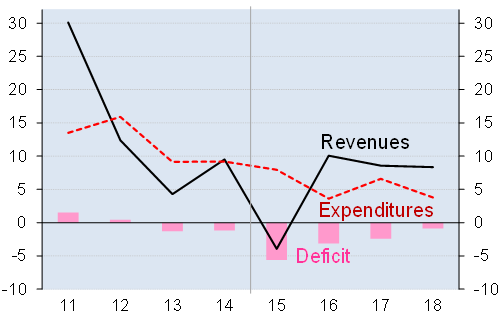BOFIT Weekly Review 27/2015
Russian government budget framework assumes lean years ahead
In its latest budget framework proposal to the government, the finance ministry expects the nominal value of government revenues to fall this year about 4 % in ruble terms. Revenues relative to GDP will decline to 35 %. The revenue projection is based on the economy ministry’s forecast, which cautiously assumes the price of oil this year will average $50 a barrel. GDP is expected to contract 3 % this year and inflation to average about 15.5 %.
The ministry expects nominal federal budget revenues to fall this year by close to 15 % on a 25 % drop in tax revenues from oil and gas. Tax revenues raised by regional and municipal governments should increase about 6 %, but their total revenue growth will only amount to 2–3 %, because transfers to regions from the federal budget will be reduced significantly. Government social fund revenues will climb by over a fifth, because asset transfers (especially to the pension fund) will increase sharply. Tax revenues to these funds will also grow relatively well.
The ministry estimates that government spending will increase 8 % this year in nominal terms, and that the share of spending will rise to nearly 41 % of GDP. Federal expenditures, excl. transfers to other budgets, will grow a bit more (when figures exclude the large bank support paid out in December 2014). Regional and municipal budget expenditures will increase a mere 5 %. In contrast, social fund expenditures will increase by roughly one quarter.
The finance ministry calculates that the government deficit will worsen this year to 5.5 % of GDP. The federal budget deficit will be over 3.5 % of GDP. Financing the gap will be accomplished by depleting about half of the federal government’s Reserve Fund. Regional budget deficits will be funded in part out of loans from the federal budget. The finance ministry is concerned about regional deficits and has proposed a legal deficit limit to be imposed on regional budgets that would be proportional to regional budget revenues without federal budget transfers.
The revenue estimates for the years ahead assume an oil price averaging $60 a barrel in 2016 and $65 a barrel in 2017, as well as GDP growth above 2 % a year. Government revenues would recover in the period. However, the ministry’s calculations indicate that nominal spending growth would have to be limited to 5 % a year, i.e. slightly below the forecast inflation rate. In such case, the government deficit would be constrained to 2.5 % of GDP in 2017.
Change in government revenues and expenditures (%), and deficit (% of GDP)

Source: Finance ministry